|
< Earlier Kibitzing · PAGE 2 OF 2 ·
Later Kibitzing> |
| Dec-19-14 | | Dr. J: ...and I see that <An Englishman> has basically written the same thing, in rather more elegant prose |
|
| Dec-19-14 | | agb2002: Black has a bishop and a knight for the bishop pair. White threatens 29.Rxe7.
The first idea that comes to mind is 28... Qxe1+ 29.Bxe1 Rxe1+ 30.Bf1 Ra8, threatening 31... Raa1: A) 31.Rb2 Raa1 32.Rf2 Bd4 and Black wins decisive material. B) 31.Kg2 Raa1 32.Be2 Ra2 wins the remaining bishop. For example, 33.c5 dxc5 34.d6 Rxe2+ 35.Kg3 Rxh2 36.Qb7 Bf6 37.Qc8+ Kg7 38.Qxd7+ Kh6 followed by ... Bh4+ Kf3 Rh3#. C) 31.c5 dxc5 32.d6 Raa1 is similar to the sample line in B. |
|
| Dec-19-14 | | agb2002: I missed the simple 33.Kf2 in my line B and Black only ends up B+N vs R. I should remember Lasker's recommendation more often. |
|
| Dec-19-14 | | gofer: After Qxe1+ black dominates the white position. Its not over but white has very few
good moves and very little space. Not an immediate win, but a very strong position. <28 ... Qxe1+>
<29 Bxe1 Rxe1+>
<30 Bf1 Ra8>
<31 Qf2 Raa1>
<32 Kg2 Rxf1>
<33 Qxf1 Rxf1>
<34 Kxf1 Bh6>
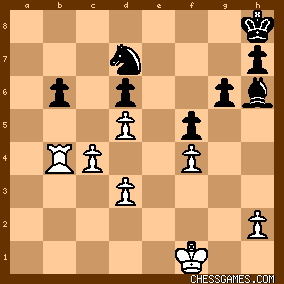
click for larger viewNot a slam dunk, but this should be a win as long as black is careful! ~~~
Hmmm, gonna need some help here... ...what does <Herr Fritz> have to say on white's best defence? |
|
| Dec-19-14 | | Once: Tricky, tricky.
The first bit is straightforward. In puzzle land, if our queen is attacked we sacrifice it. So let's look at ... 28... Qxe1+ 29. Bxe1 Rxe1+ 30. Bf1 Ra8

click for larger viewHere white goes wrong with 31. Kg2 allowing 31...Ra2+ when general yukkiness will ensue. Instead, surely white plays 31. Qf2 to protect the f1 bishop and prepare for Kg2. Then we might get 31... Raa1 32. Kg2 Rxf1 33. Qxf1 Rxf1 34. Kxf1
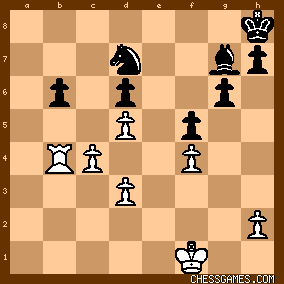
click for larger viewI'm not sure how to call this one. Fritzie is saying that black is a pawn up with an eval of -1.17. The black plan of 34...Bh6 and 35...Bxf4 doesn't work because white can allow the f4 pawn to be captured and then play c5 with a discovered attack on the Bf4 and the c pawn is rushing forwards. But how does black win this one? Presumably he puts his bishop somewhere sensible - say d4-c5. Then he plays Kf6 with the plan of h6 and g5? I can't see black losing this one, but there's a lot of play left in it. White might be able to play Ra4 and Ra7 or Ra8 creating mischief behind the black pawns. And that's where I ground to a halt in both human mode and with Fritz's assistance. The queen sac seems to be the best move in the position, but it should not have been the knockout blow that happened over the board. |
|
| Dec-19-14 | | Caissas Clown: Ice-cool calculations by Yudasin.I think I =might= have played this , if I could have got my rook to A8 one move earlier.
Once you play through the game from the comfort of your chair , it's all nice and clear , but not so simple OTB. I guess that is why Yudasin is a GM -and I ain't ! Anyway , well played , Leonid ! |
|
| Dec-19-14 | | morfishine: After <28...Qxe1+> 29.Bxe1 Rxe1+ 30.Bf1
I had <30...Bd4> (instead of 30...Ra8) which prevents
31.Qf2
I then had the same <31.Kg2> and finally 31...Ra8 I wonder if this is good enough:
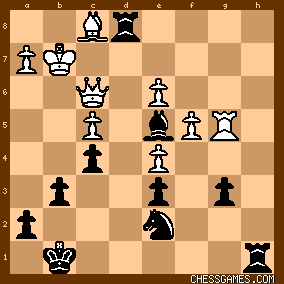
click for larger view***** |
|
Dec-19-14
 | | Penguincw: 28...Qxe1+ 29.Bxe1 Rxe1+ 30.Bf1 Ra8 31.Kg2 Ra2+ 33.K (any) and that's about as far as I calculated. |
|
| Dec-19-14 | | TheaN: Friday 19 December 2014 <28....?> In this starting position the key is the control of the e-file. White is 'threatening' to take the e-file after the black queen moves with 29.Rbb1, and because black is facing the bishop pair the endgame can be tricky for white. At least; if, the black queen moves. Because she will move. Forward. <28....Qxe1+!> a blow in the face for white, whom sees his plan of taking the e-file backfire, in return gaining a queen for rook and bishop. In this scenario it will show that black's two rooks and dark square bishop outperform the white queen and rook. The black knight is very strong against the bishop on g2. White has no alternative, because the bishop on d2 is en prise. After <29.Bxe1 Rxe1+ 30.Bf1 (Qf1 Rxf1+  ) <30....Rbe8>. White is in big trouble. If black can keep reloading pieces with R8e3 or Bd4 white will eventually lose the bishop on f1 (or the queen for a rook, which is insufficient). ) <30....Rbe8>. White is in big trouble. If black can keep reloading pieces with R8e3 or Bd4 white will eventually lose the bishop on f1 (or the queen for a rook, which is insufficient). Best try seems to be <31.Kg2> to immediately solve the pin on the first rank. <31....Bd4> on itself the bishop move doesn't threaten anything, but the key is that it completely paralyzes white. b6 is additionally defended, the bishop on f1 still cannot move. <33.Ra4 Nf6 34.Ra7 Ng4 35.Qh3 h5> countering white's only threat. <36.Qh4> what else? <36....Ne3+  > and the black pieces prevail. > and the black pieces prevail. |
|
| Dec-19-14 | | wooden nickel: Along the most logical looking played 31...Ra8 and the suggested 31...Bd4!, another alternative move is 31...Nc5 and White can hardly move, if 32.Kg2, then Bd4 cramping the game even more for White.

click for larger view
It's too strong! |
|
| Dec-19-14 | | TheaN: It seems I am the only one prefering Rbe8 over Ra8? The latter is much more direct, but in the end it 'just' comes up two pieces for a rook. Lets see what the silicon monsters say. Okay, I missed a clear defense for white. After <30....Reb8 31.Qf2!> preventing Bd4 <31....Nf6? 32.h3!> keeps the black pieces out. The defense with <31.Kg2?!> does in fact put white in peril but it's still difficult after <31....Bd4 32.c5! Bxc5 33.Ra4 b5! (Nf6? 34.d4!) 34.Ra6 Nf6 35.d4 Bxd4 36.Rxd6 Ra8!  > , which I hadn't seen as far. After 31.Qf2 though, black can't break through because of his own king's safety <31....R8e3? 32.Ra4 > , which I hadn't seen as far. After 31.Qf2 though, black can't break through because of his own king's safety <31....R8e3? 32.Ra4  > and the weakness on b6. > and the weakness on b6. |
|
| Dec-19-14 | | TheaN: After some more thought the silicon monster gives black a small edge after <30....Rbe8?! 31.Qf2! Bc3! 32.Kg2!!> as Bxb4 meets Qb2+ and white will win at least a piece back. Now <32....Nf6 33.h3!> again controlling g4 <33....Bxb4 34.Qb2 Bc5 35.Qxf6+ Kg8 36.d4  > black is not worse but not much better either. > black is not worse but not much better either.Interesting positions. |
|
| Dec-19-14 | | varishnakov: 28...QxR+ 29.BxR RxB+ 30.B-B1 R-R1 31.K-N2 R-R7+
But, then I went astray. Seeing the bishop move played, it seems obvious, but I didn't consider it. |
|
| Dec-19-14 | | kevin86: White's king is chased from home and black soon after pins the queen. A lot is done after the black queen sacrifice for rook and bishop...a small price to pay. |
|
| Dec-19-14 | | Bycotron: Black to play, move 28.
My Queen is under attack by the white Re1 so I need to resolve this situation. I can move her Highness, destroy the attacker, interfere along the line of attack, or make a more eminent threat for black to deal with. No immediate Queen moves/retreats seem to set white any special problems - e.g. 28...Qh4 29.Rxe8+ The only interference square available is e5 and placing either the Knight or Bishop there seems to accomplish little other than suicide. The most forcing course of action then turns us to 28...Qxe1+ 29.Bxe1 Rxe1+ 30.Bf1 when if I could play my second Rook to the first rank I would win! Let's examine the initial position one more time... 28...Ra8 29.Rxe7 Ra1+ 30.Bf1 Rxe7 and white has stopped my Rooks from doubling on the first rank. So back to the previous line... 28...Qxe1+ 29.Bxe1 Rxe1+ 30.Bf1 Ra8! comes just in the nick of time! 31.Kg2 is the only move that stops my Rooks from doubling and eating the Bf1. 31...Ra2+ 32.Kh/g3 Bd4! should rap things up.
Hail! What a pretty combination! |
|
Dec-19-14
 | | chrisowen: I have to lambaste queen rook over apart,
from that pretty good ha mind a link in aloof old bam e7 down light cant bale out eg saint gets swallowed too and black has couple of pieces for the queen and attack soon rooks at gain the fray and back rank looks weak win either of have bishop and queen swallow for rooks, or bat pin queen upon king's a pave fold
hop along clean a link bank boot in took
queen swanky tomb hope afloat over
affront in flinch a rove dash a scripture at the very least black should be able to win back couple of pieces me a golly am line off in f1 and endgame looks better glide an inter knight an bishop g7 versus right rook b4 probably a plus one advantage street g7 senses eg ment d7 gets like a lion larger d7 in zion step or nip in the bud b4 pogo stick to paz it a jewel again a light opportune thought match off efile back fires prayer e7 mat cashes in manage haves e1 wave any cajole e7 down recind a dink jod hopper e7 i ment soldier e8 down also tat for tat a safe boat wrap around a king's a flap engages a g2 bad as h3 also doesnt compute well stay put kind infer a f2 able as track back a g2, at h1 am why pot dilemma light goes wrong alive no more a g2 as bank i a2 carry in light at backs off a gg similar sentry am castle go wracked a8 in a2 boot as right rig queen get pinned to king's a face pin ever a g2 who'll dispute a8 wins by infiltrated vow in degrees am fly off for won am flight aim cred clink in cad better glide gold for black ash each a dipoff am got i believe in dug guffaw a go basher bet ram good game thod in a g2 hood wink glean cutoff |
|
| Dec-19-14 | | stacase: 34 ... Re3 Har! |
|
| Dec-19-14 | | dfcx: 28...Qxe1+ 29.Bxe1 Rxe1+ 30.Bf1 Ra8

click for larger view
A. 31.Kg2 Ra2+ 32.Kg3 (Kh4 -same) Bd4! and the queen has no escape against Re3!
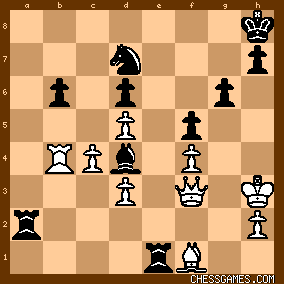
click for larger viewB. 31.Qf2 (guarding d4) Ra1 32.Kg2 Bc3!
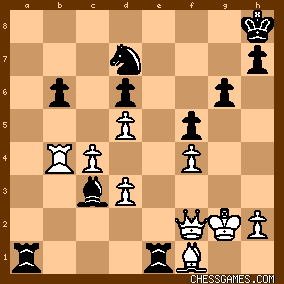
click for larger view
33.Rb3 Rxf1 34.Qxf1 Rxf1 35.Kxf1 Bc2 wins
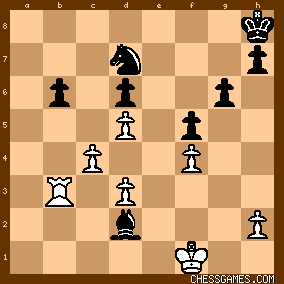
click for larger view |
|
| Dec-19-14 | | dfcx: the last move for black should be 35...Bd2 in my previous post |
|
| Dec-19-14 | | Longview: Well, I looked at the obvious exchange of queen for Rook and Bishop but wondered if the ploy of 28...Qh4 was a viable plan. This allows 29. Rxe8 Rxe8 and the white Bishop as the lone defender of the e1 square. Unfortunately, the tempi being swapped allows 30. Rb1 both protecting against black entering the back rank with a rook and reinforcing defense of that square. I think the attack wains from that point. Were that not the case Black might be able to get to the back rank with the Queen intact! Oh, well, back to the thinking board and Plan A. I did not see the support of the attack with Ra8, however. That is clearly a clincher irrespective of White's move order to get his King to g2. I like the suggestion of 31.Qf2 and 32. Kg2. The logic is strongly defensive. Looking at the play of the game, I was interested to note the effect of Black's fianchettoed bishop on g7. Many of the moves are all dancing around preventing black being able to deliver on his threat of ....Bd4 which looked to be a nice home for the Bishop or a Knight as was seen eventually in the game. I don't usually notice those things. |
|
Dec-19-14
 | | Jimfromprovidence: <dfcx>...<33.Rb3 Rxf1 34.Qxf1 Rxf1 35.Kxf1 Bc2 wins> 
click for larger viewI got the same line.
Black has to watch out for 36 Ra3, below, seeing 37 Ra8+. 
click for larger view
In response, black has to be ready to move the knight or play 36...Kg8. |
|
| Dec-19-14 | | DarthStapler: I got the first two moves |
|
| Dec-19-14 | | barryh1976: Is chrisowens retarded? |
|
| Dec-19-14 | | Edeltalent: 28...? Black to move
Material is equal, the position looks rather quiet. b6 is weak, but Black's pieces are well coordinated. His queen is under attack, so choices are limited. 28...Qh4 looks to be a decent move, but 28...Qxe1+ is what you'd love to make work. After 29.Bxe1 Rxe1+ 30.Bf1, for a small material investment, Black has gained complete control over the position, especially the dark squares. The white rook looks very awkward, as his natural defensive route b2-e2 is cut; the white queen is tied to the bishop, which himself is pinned and passive anyway; the white pawns restrict his own pieces instead of the black ones. So the question for Black is how to infiltrate with his pieces while keeping his iron grip and preferrably not allow any counterplay. 30...Ra8 is certainly a candidate to invade via a1 or a2, 30...Bd4 also looks very attractive, further restricting the queen by controlling f2 and preventing a freeing pawn push to d4. Maybe 30...Rbe8 is an idea to put pressure on the queen with R8e3 next, but at the moment looks a bit vague. Let's calculate some variations with 30...Bd4:
- 31.Kg2 Ra8 32.Qg3 Ra2+ and the king has nowhere to go without dropping the bishop or the queen. - 31.h4 Ra8 32.Kh2 Ra2+ 33.Bg2 Bg1+ 34.Kh1 Bc5+ wins the rook and 34.Kh3 Re3 the queen - 31.Ra4 Rbe8 32.Kg2 Rb1 (R8e3 33.Qf2 and I don't see a good followup) with the threats 33...R8e3 and 33...Rb2, but 33.Ra2 doesn't seem clear. - 31.c5 dxc5 32.Rxd4 cxd4 33.Qf2 or 31...Bxc5 32.Rc4 Ra8 33.d4 Ra1 34.Kg2 also gives White chances. Maybe 30...Bd4 is a bit slow, let's see 30...Ra8 next:
- 31.Kg2 Ra2+ 32.Kh3 Bd4, and if White is not easily embarrassed he might continue with 33.Qh1 Re3+ 34.Kh4 Bf6#
- 31.Qf2 Ra1 32.Kg2 Rxf1 33.Qxf1 Rxf1 34.Kxf1 Bh6 35.Ra4 Bxf4 36.Ra7 Nc5 37.d4 Nb3, this must be winning, although some work remains
- 31.d4 Ra1 32.Kg2 Rxf1 (Black can't blow White off the board with 32....Ra2+ 33.Kh1 (33.Kh3 Bxd4 34.Rb3 Nc5) Bxd4, because after 34.Qd3 Rf2 drops the bishop with check and Bc5 loses to 35.Qc3+) 33.Qxf1 Rxf1 34.Kxf1 Bxd4 and again Black is winning with two pieces and a pawn for the rook. I can't see anything better for White, his pieces are just dominated and he can't untangle himself in time. |
|
| Dec-20-14 | | patzer2: <Once> Nice piece of analysis, showing a slight advantage but no sure win for Black after 28... Qxe1+ 29. Bxe1 Rxe1+ 30. Bf1 Ra8 31. Qf2!  . . In the final position if 35. Qxf3, then 35...Bxf3 walks White into a mate after 36. Rc8+ Kg7 37. Rc7 Bxf4! 38. Rxd7+ Kh6 39. any move, followed by 39...Rxh2#. |
|
 |
|
< Earlier Kibitzing · PAGE 2 OF 2 ·
Later Kibitzing> |





